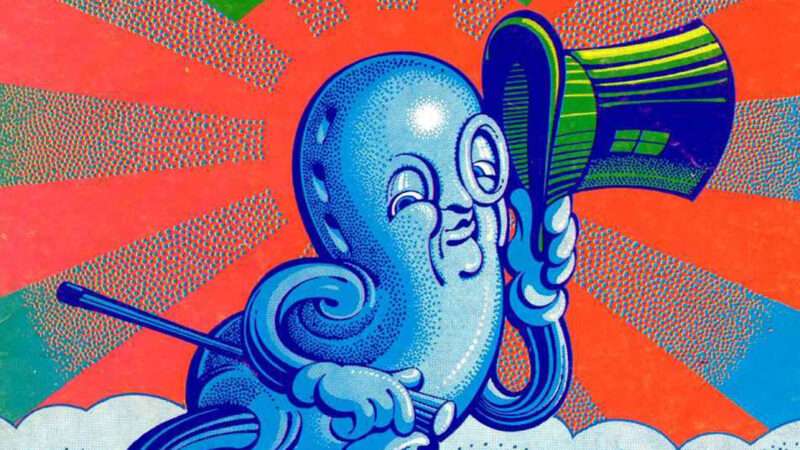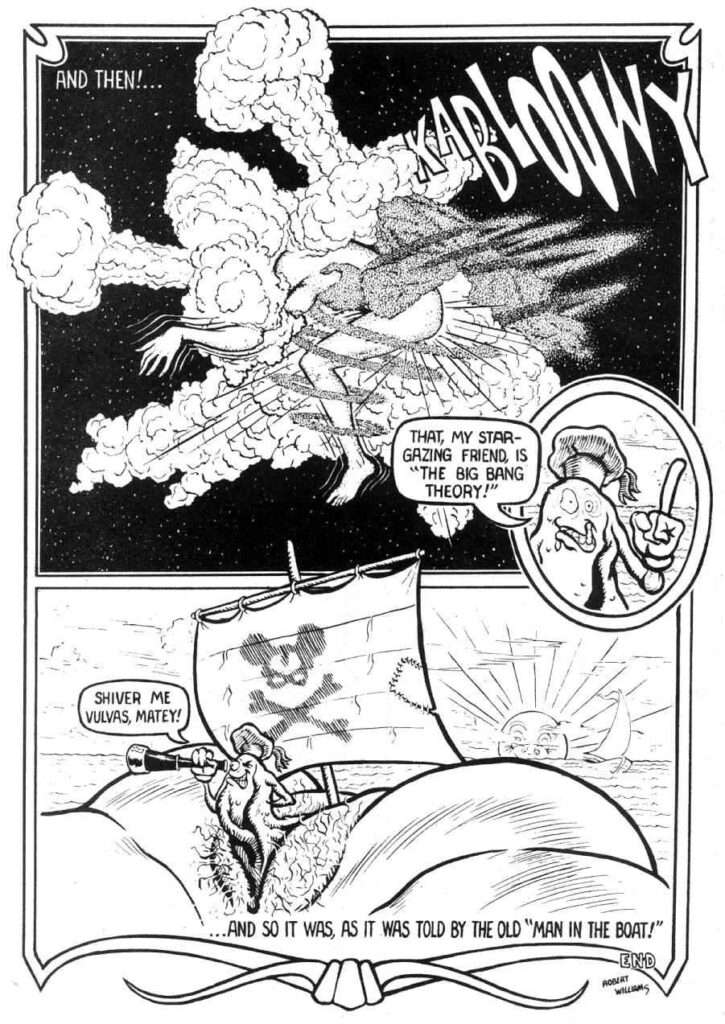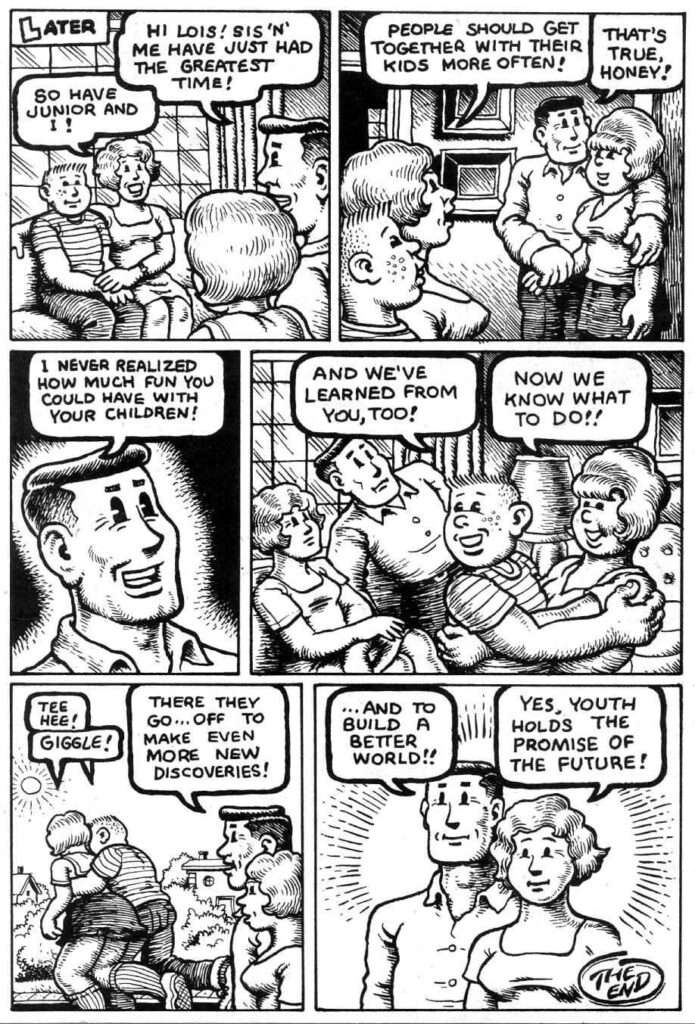
In 1969, in an atmosphere of simmering animus toward youth culture, an undercover agent from the New York Police Department's Public Morals Squad visited two bookstores to buy copies of Zap No. 4. This minor bit of commerce had violent repercussions. "This bearded guy pushed the door open aggressively and said 'OK, this place is closed down!'" remembered Terry McCoy of the East Side Bookstore. "I thought he was a street guy. I instinctively blocked the entrance. 'Hey, buddy,' I said, trying to calm him down and get him outside, 'what's the problem?' He said, 'You work here?' I said, 'Yes,' and he said, 'You're under arrest.'" McCoy, the boss, and another employee were all taken to the precinct and then the Manhattan Detention Complex.
Zap No. 4 is an anthology with stories and drawings by seven different cartoonists: Robert Crumb, S. Clay Wilson, Rick Griffin, Victor Moscoso, Spain Rodriguez, Robert Williams, and Gilbert Shelton. Their tales include everything from sexual torture to an anthropomorphic clitoris, but the star of the lurid show, the most unmistakably offensive and troublesome story—so far beyond what anyone might call "problematic" today—is "Joe Blow," written and drawn by Crumb. We see a father watching a blank TV, musing that he "can think up better shows than the ones that are on," who then stumbles upon his masturbating daughter. From there, things degenerate into an incestuous orgy, with the characters drawn to seem more toylike than human. In the end, after the dad declares "I never realized how much fun you could have with your children," the strip shifts into a mock-socialist propaganda mode. The kids, we are told, are "to build a better world!!" "Yes, youth holds the promise of the future!"
The New York Times asked Crumb about this comic in 1972: "What was your intention?"
"I don't know. I think I was just being a punk."

Just four years prior, Crumb had been making a living drawing funny greeting cards for American Greetings in Cleveland, but he'd transitioned into a career of blowing hippies' minds with cartoons in counterculture tabloids such as Yarrowstalks and the East Village Other. In 1968 he broke into the mainstream with his anthology Head Comix, published by Viking. He garnered praise from a variety of generational gatekeepers, and his art graced the cover of Big Brother and the Holding Company's Cheap Thrills, an album that topped the charts for eight weeks. And now he was inadvertently responsible for getting booksellers dragged to prison and forcing publishers into hiding from the authorities.
Revenge of the Smartass Rebel Cartoonists
Zap No. 4 was an example, an archetypal example, of what were called "underground comix." Its artists' work in other places—album covers, rock posters, underground newspapers, T-shirts—defined what it looked and felt like to be young and strange and rebellious (or to believe you were) in the late '60s.
Unlike most comic books sold in America, the undergrounds did not subject themselves to the authority of the Comics Code, whose seal emblazoned the top corners of every comic you were apt to find on a newsstand, in a drugstore, or on a convenience store rack. To get that seal of approval, your comic had to be middle-American wholesome. It had to eschew "profanity, obscenity, smut, vulgarity" and "suggestive and salacious illustration or suggestive posture" and any "ridicule or attack on any religious or racial group." None of these were things that Crumb and his colleagues could be relied on to avoid.
Underground comix (the x to mark them as distinct from the mainstream) were not distributed by the sort of jobbers that were trucking around Time, Better Homes and Gardens, or Family Circle. They were distributed by hippie entrepreneurs, some of whom might also be slinging drugs, and they generally appeared alongside drug paraphernalia (such as pipes and papers for help ingesting drugs, or posters that made you feel like you already had). Though some were periodicals, many were one-shots either by design or by their creator's lack of follow-through. They were not sold as ephemera to be destroyed at the end of every month with the publisher eating the expense of unsold copies, like mainstream comics were. More like books, they would sit on shelves getting more and more dog-eared by the hands of curious thrill-seekers who might not dare to actually buy them and take them home (or who couldn't afford to).
Underground comix creators didn't just do art differently; they insisted on doing business differently—and, in doing so, eventually changed the mainstream comics industry as well. They had no interest in dealing with the existing mafias of periodical distribution or the corruption of its returns system; underground comix were thus sold nonreturnable to independent retailers enmeshed in rebel youth culture, without outside sponsors' ads coming between their message and the reader. Most importantly, the artists themselves remained the owners of their work. They were paid royalties like real authors (at least theoretically) and not merely upfront page rates as work-for-hire; and underground comix publishers printed and distributed what the artists chose to create, not vice versa.
Much of what made America juicy, zesty, strange, scrappy, devil-may-care, irresponsibly fun, and chaotically strange in the past half-century flowed through and/or out of this loosely assembled band of brothers and sisters: from hot-rod magazines to funny greeting cards, biker gangs to homemade mod clothing, psychedelic rock to science fiction, cheap girly mags to women's liberation, smartass college humor magazines to karate, Wacky Packages trading cards to surfing, communist radicalism to born-again Christianity, transsexualism to graffiti. They fought and lost legal battles with Disney and vice squads across the nation; they labored for 25 bucks a page or less and reshaped their despised art form into a now essential part of the cultural repertoire of any educated hip adult.
Unlike some other countercultural pop culture products—say, rock music—underground comix were genuinely subterranean, unsupported by major corporations or distributors. They were mostly a dark secret you needed to stumble across in the search for other quirky or forbidden kicks, or be initiated into by a previous acolyte, like some occult rite of passage.
Despite, or because of, that, underground comix became an essential accoutrement of a counterculture life, even as they frequently mocked, satirized, and critiqued counterculture life. They were absurd, scatological, goofy, innovative, scary, beatific, thrilling, heartbreaking, and sometimes shoddy, but in all their manifestations they brought pleasure, insight, and bewilderment to millions while seemingly designed to have their off-register, scrap paper, cheaply printed, stapled bodies fall to pieces in a damp rack in some grotty group house's bathroom damp with Bronner's residue. Still, many of them have been carried into the consciousness of later generations via pricey, highly designed hardcover box sets (or on museum walls).
Underground comix were born of smartass rebel kids yearning to push back vigorously against the limits of what their culture considered acceptable or allowable. These young artists were nearly all motivated at least in part by the knee-jerk censorship of the 1950s. In that decade, respected psychiatrists, Senate subcommittees, and mothers across the nation had decided comic books, especially the ones smart weird kids loved the most, had gone too far. Mainstream comic companies reacted with the self-imposed Comics Code, and the publisher these kids admired the most—EC Comics, home of Tales From the Crypt, Shock SuspenStories, Weird Science, and Mad—shut down all the horror and science-fiction stuff and turned Mad into a magazine. And eventually the censors came for the undergrounds too.
Sell a Comic Book, Go to Jail
The managers of those two stores selling Zap were convicted of selling obscene material and fined $500 apiece—almost $4,000 in today's money. It wasn't the last time an underground comic got someone into legal trouble. Even the famed Beat poet Lawrence Ferlinghetti had to go to court in 1970 to answer for his City Lights Bookstore selling Zap No. 4.
A Van Nuys, California, man running an explicitly "adult books/art film" shop called Swinger's Adult Books was arrested for selling Zap and Crumb's Motor City Comics in September 1969. A vice officer involved explicitly said, as reported in the Hollywood Citizen-News, that the "warrant was issued on these two publications because they had also been used as examples of pornography in other legal cases. Precedent-setting court action would aid in prosecution…adding that 'dirtier' material was being sold here but was not involved in the arrest." The arrest was triggered by complaints from a local women's club, a representative of which noted that "the type of material to which we refer does nothing to aid in the development of a healthy mental attitude."
Ripples of fear from the Zap busts spread. Comics collector Glenn Bray told Bijou Funnies editor Jay Lynch he was having a hard time finding the new issue in the Los Angeles area in June 1970, warning him that "L.A. is really down on all the underground comix—the cops hassle everybody too much, and I guess the vendors don't seem to think [selling comix] is worth the trouble." Young Lust, one of the best-selling titles of the early 1970s, ended up with hardly any New York newsstand presence for a while because distributors there were, to quote Young Lust editor Jay Kinney, "chickenshit" about naughty comix after the Zap bust.
Bud Plant, an early comic book store and distribution pioneer, remembers at a Phoenix, Arizona, convention in the early 1970s having "a bunch of underground comix there, and we were at a Ramada Inn or something like that. One of the kitchen staff or one of the cleanup people that night had wandered into the dealer's room after it was closed, picked up some of my undergrounds and took them back to the kitchen, was reading them and then left them laying around. So the next thing we knew the hotel people came in to [the convention organizer] and said, 'We didn't know you guys were selling pornography here.'" The organizer did some fast talking, the undergrounds were put away, and no one got arrested.
At another convention, in Berkeley, California, organizers built plywood walls around their display of potentially obscene art and slept in the makeshift room all night to protect it.
When the folks at the comix publisher Last Gasp shipped titles to England, they would deliberately bury the more gnarly items in the middle of the box, below slightly more anodyne ones, and cross their fingers about how deep the Brit customs boys would dig. Felix Dennis, later a billionaire publishing magnate, was sentenced to nine months in jail for violating Britain's Obscene Publications Act for his role in publishing and distributing the underground magazine Oz, though he served less than a week before public pressure on his behalf got him out pending appeal, and he ended up with a suspended sentence. One of the offending things Oz ran was an image of a sexual Crumb cartoon with the head of the British children's favorite Rupert the Bear superimposed.
In 1973, the U.S. Supreme Court declined to take on an appeal of the New York Zap case. That same year, in Miller v. California, the Court issued a decision with fateful effects on the underground comix business. This ruling allowed the standards of obscenity to be fine-tuned to specific jurisdictions in which an item was sold, so the things that might be legally tolerated in San Francisco didn't have to fly in Kankakee, Illinois. The specific facts of the case involved a porn mail-order catalog, but it hit hard at the business of selling cartoon images of sex.
Miller came down in June. By August, Denis Kitchen—founder of Kitchen Sink Press—was sending out a form letter to his artists/creditors, summing up the perfect storm of woes haunting their little cottage industry, starting with the aftermath of that decision: "Underground comix have been the target of prosecutors in several areas. We have received reports of busts in New York, New Jersey, and Iowa, and unconfirmed reports of busts elsewhere. In one instance in New York, the owners of a head shop were arrested and dragged out in handcuffs for selling underground comix."
A sympathetic insider at the police department gave a warning to Don Schenker, majordomo of Zap No. 4 publisher Print Mint, a day before he was raided. He was thus able to get most of the more obviously obscene comics out of their warehouse and into a safer space just before the cops came. For the next year he sold the likes of Zap No. 4 bootleg-booze style, only to people he personally knew, with the offending books never being on Print Mint property. He was not convicted.
Even art galleries were not immune to vice raids. The first Bay Area art show dedicated to underground comix art at the Phoenix Gallery was raided and gallery owner Si Lowinsky arrested. He was acquitted, even though he had been selling the very porny Jiz and Snatch comics, copies of which were seized. Peter Selz of the University of California, Berkeley's art museum, called as an expert witness, judged them "not the greatest of art, but it certainly makes one laugh." The jury, Lowinsky later said, "decided that people have a right to symbolically represent all sorts of outrageous acts, and that society has no right to ban such representations."

But not every case ended in an acquittal, and every arrest could have a chilling effect. As Zap cartoonist Robert Williams would later say, "Me and Crumb, we knew the things we drew, someone was going to have to pay for." And they did, mostly shopkeepers and clerks, in numbers Williams swears were in the hundreds.
From the Gutter to the Gallery
With zero institutional support, the undergrounders drew not just opposition but condemnation—cultural, artistic, and legal. Still, they couldn't be stopped. Underground comix brought comic art to the courtroom, but down the line they brought the form and its creators to Pulitzer Prizes, New York Times bestseller lists, MacArthur "genius grants," Emmys, and the Whitney Museum of American Art.
The artists' fates were intertwined—and varied. Robert Crumb became a wealthy expatriate icon; S. Clay Wilson, who helped make Crumb what he is, lay brain-damaged for more than a decade in his rent-controlled San Francisco apartment from injuries caused by his out-of-control drunkenness. Art Spiegelman won a Pulitzer Prize and a Guggenheim Fellowship and became the leading intellectual spokesman for the entire art form; Jay Lynch, one of his best friends, who as a teen had passed out copies of the absurd cartoons they drew together to strangers, died nearly destitute and forgotten. Bill Griffith has thrived for decades at the eternal summit of the working cartoonist, a syndicated newspaper strip, while his old pal Roger Brand, who inspired him to create that strip's central character, Zippy the Pinhead, died decades ago as a burned-out speed freak selling pages to strangers for beer money. Robert Williams can pull in high six figures for a single painting, while Trina Robbins was driven out of drawing entirely by the toxic psychological aftereffects of gendered interpersonal warfare in their tight little scene.
The skeptic might dismiss underground comix as the jokey sick nonsense a hormone-raged hostile smartass adolescent boy might be scribbling in his notebook in the back row, bored and resentful of his teacher. A lot of it is like that. Yet so much would be different without the underground comix creators and their influence, from the look of the modern New Yorker to the classic iconography of rock 'n' roll. No mainstream New York imprint would be publishing graphic novels without them, nor would major universities be teaching comics aesthetics or history. The Simpsons would not exist, nor would any modern adult animation. Even the modern superhero comic would be wildly different—Alan Moore, the British writer of Watchmen, first broke into the U.S. comics market in an issue of the underground Rip Off Comix.
Underground comix gave a later generation of (im)maturing cartoonists something they needed to thrive: a sense of permission to dare to be who they could and wanted to be, to dig to the core of their talents and selves. It meant a lot, and it still does.
This excerpt is adapted from Dirty Pictures: How an Underground Network of Nerds, Feminists, Misfits, Geniuses, Bikers, Potheads, Printers, Intellectuals, and Art School Rebels Revolutionized Art and Invented Comix by permission of Abrams Press.
The post <em>Zap</em> Comix Were Never for Kids appeared first on Reason.com.






